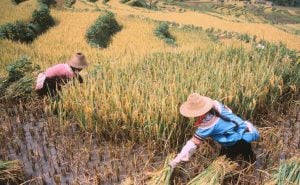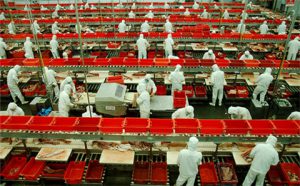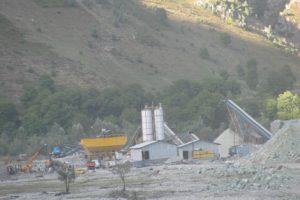Tom Levitt (TL): What are the dietary changes going on in China today?
Barry Popkin (BP): There are three or four big changes taking place. Firstly, people in China are purchasing more and more of their food from retailers, be they convenience stores, medium-sized supermarkets or mega-markets. And with this is coming an increase in the purchase of processed and prepackaged foods. Secondly, one of the biggest changes in terms of nutritional impact is the very large increase in animal protein foods. At one point it was pork, but now it is poultry.
There is also an increase in dairy consumption but, given the quality of the Chinese diet, this is not necessarily a negative issue, except for its impact on the environment. The total animal-sourced foods is not that excessive compared to the rest of the world – it’s much less than in Europe or the US – but it’s just that the growth of it doesn’t seem to be slowing down at all. And it's having a large impact on the environment in terms of water availability and climate emissions. Thirdly, the other element of the diet is the continuous increase in the consumption of edible oil and deep-frying of foods, moving away from steaming and baking. The Chinese now consume 300-400 calories a day of oil.
Fourthly, a new issue that never existed in China 20-30 years ago was the consumption of sugar. Today China has a sugar reserve. You won’t find a village or small town where they don’t have confectionary and somewhere to buy pastries and soft drinks. It’s becoming a new element in the Chinese diet that didn’t exist before. They consumed two grams of sugar per person per day in 1990 and people laughed at the thought of it being part of the Chinese diet.
TL: Is the speed of transformation in the Chinese diet comparable to any other region and what is its impact?
BP: China’s speed of change of diet in two years equals that of Japan during its most rapid changes of income last century. China’s speed of change in snacking, beverage consumption, meat and oil intake has exceeded every other part of the world. The same goes for supermarkets which grew from US$9bn in 2001 to US$91bn in 2009 and are accelerating their growth – you’re now finding convenience stories in every small town, huge chains from Hong Kong and South Korea and even some from the West.
The problem is that all these changes are occurring and the government is doing nothing. If anything it is accelerating these changes by subsidising and keeping sugar prices low, keeping pork prices down, not really thinking through the long term health consequences for its economy and the medical costs that are going to come from the hypertension, diabetes, heart disease and cancer from all these diet issues, compounded by other environmental concerns.
The biggest problem from a health point of view is the quality of the diet, the frying, the oil, the lack of vegetables being replaced by refined carbohydrates and increased animal protein. It’s the reason why Chinese non-communicable diseases are growing very rapidly. Our national survey shows adolescents in China have triple the diabetes rates of US adolescents. The Chinese are very vulnerable to health problems at much lower weights and body mass than Western. A Chinese person going from a BMI of 21 to 24 is going to get diabetes and hypertension.
TL: What impact is urbanisation having on diet and health?
BP: It goes hand-in-hand with this. As you go from the mega-cities we studied (Beijing, Chongqing) down to the small cities, towns and rural areas, you did in the past see the obesity and chronic diseases fall. But now we have a faster growth in the rural areas and amongst low-incomes. Partly because modern technology has reduced their energy expenditure and their diet hasn’t shifted that much and partly because they have access to cheap foods with every village having convenience stores, which are often half junk food. It’s changing the nature of their diet very quickly and the burden of disease is shifting to more lower-income populations.
TL: What’s the trajectory over the next decade?
BP: It’s one of the most rapid increases in chronic diseases, in diabetes and hypertension that we’ve ever seen in the world. Between the last generation and this generation, the average Chinese man or woman are 8-15 kilograms heavier. Unless the government take pretty strong action to control modern marketing, cost and prices of food supply then the health costs are going to be so high in the next decade that they’re going to start worrying about having a healthy labour force.
It’s a dismal picture in China and this is only talking about the diet and obesity side and not the environmental side and how they interact with each other. One of the things obesity does is reduce your immune function and therefore your ability to cope with environmental hazards – soil, air and water pollution – that exist in China today. There’s going to be an interplay of each of these issues.
TL: Are there any lessons China can learn from other countries going through similar dietary shifts?
BP: There are a number of lower and middle-income countries – Thailand, Mexico, Ecuador, Peru, Colombia, Chile and Brazil – that are really taking on what they see as a serious issue. For example, Mexico bringing in taxes on junk foods and restricting advertising on unhealthy foods. It will take several years to know if they work, but we know they did work in the Scandinavian countries.
But China is ignoring it. It’s not even talking about them. One of the biggest problems is that most of the diabetes and hypertension in China is untreated which will mean that what you will see in 15-20 years is a large body of disabled people losing limbs and getting blind from these problems.
TL: What would a healthy Chinese diet look like?
BP: If you think back to before the founding of the Republic of China in 1949 and think of the diet of 9/10ths of the Chinese, it was a very simple one of rice, vegetables and a trivial amount of animal-sourced food. It was only in the elites where the fine cuisine of the country was nurtured. Now there are different spicing patterns and so forth. The culture of eating has changed so much through modernisation, for example with frying and the use of oil. The new diet of Hunan is very different to the diet of Hunan 200-300 years ago and I don’t think that it will be easy to recover. It’s going to take very strong action from the government.
A healthier Chinese diet could be rice or wheat-based, much less oil, much more steaming, baking and stir frying of foods, more beans and a moderate amount of healthier-sourced animal foods; fish, seafoods and poultry and less fatty pork. It would go back to some of the foods they ate before like tofu, bean-dishes with much more vegetables and much less oils and sugars.
Barry Popkin is a professor of global nutrition at the University of North Carolina and coordinator of the China health and nutrition survey





